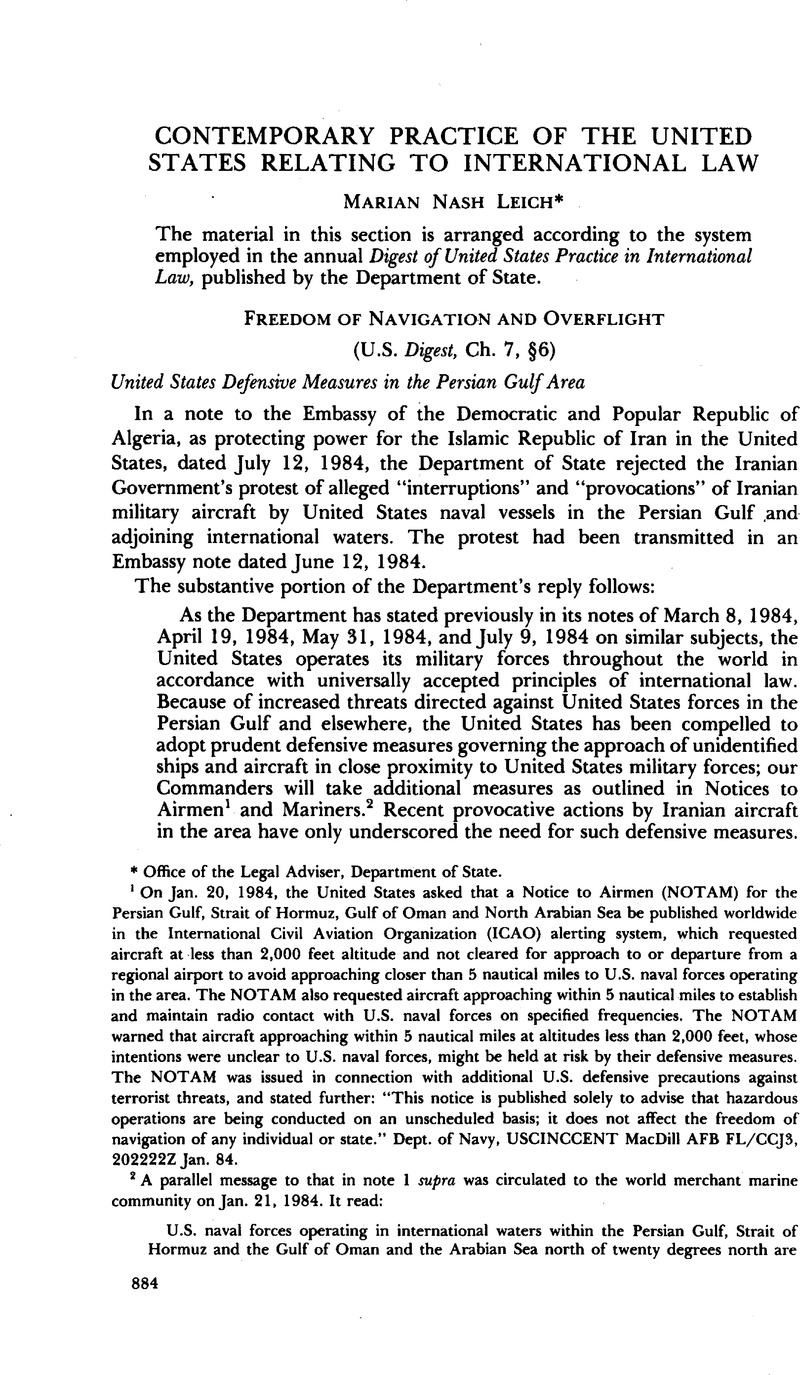Article contents
Contemporary Practice of the United States Relating to International Law
Published online by Cambridge University Press: 16 May 2017
Abstract

- Type
- Other
- Information
- Copyright
- Copyright © American Society of International Law 1984
References
1 On Jan. 20, 1984, the United States asked that a Notice to Airmen (NOTAM) for the Persian Gulf, Strait of Hormuz, Gulf of Oman and North Arabian Sea be published worldwide in the International Civil Aviation Organization (ICAO) alerting system, which requested aircraft at less than 2,000 feet altitude and not cleared for approach to or departure from a regional airport to avoid approaching closer than 5 nautical miles to U.S. naval forces operating in the area. The NOTAM also requested aircraft approaching within 5 nautical miles to establish and maintain radio contact with U.S. naval forces on specified frequencies. The NOTAM warned that aircraft approaching within 5 nautical miles at altitudes less than 2,000 feet, whose intentions were unclear to U.S. naval forces, might be held at risk by their defensive measures. The NOTAM was issued in connection with additional U.S. defensive precautions against terrorist threats, and stated further: “This notice is published solely to advise that hazardous operations are being conducted on an unscheduled basis; it does not affect the freedom of navigation of any individual or state.” Dept. of Navy, USCINCCENT MacDill AFB FL/CCJ3, 202222Z Jan. 84.
2 A parallel message to that in note 1 supra was circulated to the world merchant marine community on Jan. 21, 1984. It read:
U.S. naval forces operating in international waters within the Persian Gulf, Strait of Hormuz and the Gulf of Oman and the Arabian Sea north of twenty degrees north are taking additional defensive precautions against terrorist threats. All surface and subsurface ships and craft are requested to avoid closing U.S. forces closer than five nautical miles without previously identifying themselves. U.S. forces, especially when operating in confined waters, shall remain mindful of navigational considerations of ships and craft in their immediate vicinity. It is requested that radio contact with U.S. naval forces be maintained on channel 16, 121.5MZ VHF, or 243.0MZ UHF when approaching within five nautical miles of U.S. naval forces. Surface and subsurface ships and craft that close U.S. naval forces within five nautical miles without making prior contact and/or whose intentions are unclear to such forces may be held at risk by U.S. defense measures.
These measures will also apply when U.S. forces are engaged in transit passage through the Strait of Hormuz or when in innocent passage through foreign territorial waters and when operating in such waters with the approval of the coastal State.
This notice is published solely to advise that measures in self-defense will be exercised by U.S. naval forces. The measures will be implemented in a manner that does not impede the freedom of navigation of any vessel or State.
Dept. of State File No. P84 0110–0487.
3 Dept. of State File No. P84 0103–1034, in response to id., No. P84 0110–1525.
- 5
- Cited by




